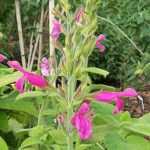Salvia dorisiana : Fruit Salad plant: a tall bushy shrub to 2-2.5m H, fragrant leaves, gorgeous bright pink flowers in spring.

Salvia dorisiana has gorgeous bright pink flowers to brighten up a garden.
Flowers: are big and fat, tubular and bright pink. The hood has masses of soft hairs. The 2 side lobes are long and thin with and the middle lower lobe extended and curled under to open up the throat area. This allows small birds with long beaks to penetrate further into the flower. Little Eastern Spinebills love these flowers as they appear after may other plants have finished.
Appearing in late winter/ spring in small whorls of 4-6 flowers on terminal spikes.Some flowers begin to open while others will open later. In this way the flowering time is over longer period, extending into late spring.
The green hairy flower stems are held above the foliage to attract passing insects and birds
Flowers can be used in a number of ways: in punches, floating with other botanicals, small posies, decorating cakes etc..
Calyces: are green and hairy , which contrast beautifully with the pink of the corolla. lobes are ribbed and pointed. If the flowers are not pollinated, they fall off when finished, leaving a green flower stem to be cut off.
Leaves: are fragrant, similar to the smell of a Fruit salad , large cordate shaped, bright green and hairy both sides with small crenulations along the margins. Leaves can also be used in flavouring of cakes.
Salvia dorisiana: is a gorgeous bushy shrub to have in the garden. Growing to 2-2.5mH it is a useful shrub for blocking out neighbours, any unsightly features or as a filler between other shrubs. It hates hot, dry winds, is frost tender so needs some protection, growing well in a sunny sheltered position.
Grow with other bushy shrubs with bright flowers or grow to brighten a dull hedge or dark shrubs. As S. dorisiana likes a semi shaded or sunny position, it is ideal growing beneath a tall deciduous tree as their branches should protect it from frost.
At the beginning of summer after most of the flowers have finished, it’s time to tidy up and cut back. Cut out any unwanted wayward branches, any dead or twiggy stems, cutting off all the spent flower stems.
Feed well and mulch to keep the root area cool during the upcoming hot dry summer season.
Propagation: easily propagated from tip cuttings, taken at any time of year. Attractive to both Birds and insects.


